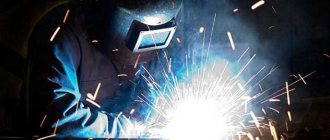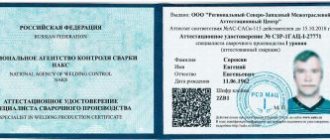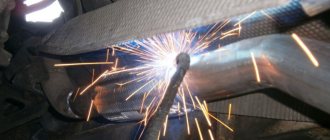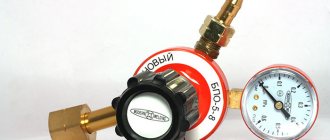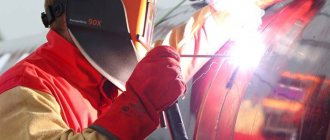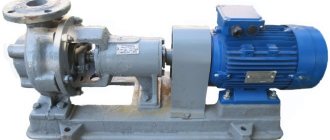The profession of a welder is not as simple as it may seem to the average person at first glance. Otherwise, special certification would not have been carried out, there would have been no qualification tests of specialists’ knowledge to extend their rank or increase it. So we can say that the work of a welder is responsible and complex, because it is he who performs labor-intensive and important welded joints and seams. A mandatory element required by highly qualified specialists is the welder’s mark. We'll talk about it today.
Type and code
In some cases, the first letters of the welder's last name or a series of numbers are used as identification. But most often the welder’s mark code is generated automatically. The basis is the specialist’s date of birth, his last name, first name and patronymic. Usually the mark does not change either during renewal, or when passing certification, or when changing the welding method.
There are several versions of the instrument. For example, numbers in two lines - without a frame or with a frame, numbers in a triangle, rhombus or square. The height of the symbols is usually 6 millimeters, however, in cases where the welder performs special work, a larger or smaller mark may be used. It is worth noting that this circumstance must first be discussed with management!
What is a welder's mark and what does it look like?
The welder's mark is a personal identifier in the form of a code of numbers and letters, which is assigned after successful certification. The tool is made from a steel rod of round or rectangular cross-section. A mirror image of the code is stamped on one end, the other end is impact. The stamp is designed to obtain a code imprint on the surface of the parts being welded after being hit with a hammer. The depth of the print and other characteristics are standardized by GOST 25726-83. The size of signs in height is usually 6 mm, but changes up or down are allowed according to the decision of the enterprise management.
The welder's mark is awarded after successful certification
When creating a brand, the symbols are stamped in the form:
- two lines without a frame;
- two lines in a rectangular frame;
- numbers in one line in a diamond;
- single line number inside a circle;
- numbers in one line in a square;
- single line number without frame.
Why do you need a stamp?
When welding particularly critical metal structures, certified welders make an impression with their mark next to the welded seam. This procedure is a sign of confirmation that a certain connection has been completed by the welder whose stamp numbers are applied to this product. That is, the assignment of a welder’s mark can be called the assignment of a kind of signature that confirms the high-quality performance of welding work.
It is impossible to confuse welders - each mark is called personal because it bears an individual number. If some kind of defect or defect was suddenly discovered, the mark could be used to identify the performer who performed poor-quality work. By the way, on October 8, 2014, federal norms and rules regulating certain requirements for work at hazardous facilities came into force. Thanks to this innovation, a single database has appeared that contains information about all certified welders. The database contains information about the position, date of certification and its field, code of the welder's mark, category, type of activity.
Deciphering the contents of the stamp
Sometimes a unique alphanumeric cipher is formed from the first letters of the surname with the addition of numbers. However, more often the code is generated automatically only from numbers and stored in the program database. Therefore, issuing two identical ciphers is excluded.
The brand is issued on the basis of an order indicating the following information:
- Full name and date of birth of the welder;
- job title;
- date of certification;
- what types of work the welder is allowed to do;
- assigned rank;
- stamp code and validity period.
The stamp is made in accordance with GOST
Where and when are they stamped?
According to paragraph 21 of the FNP “Welding at HPFs,” welded joints whose walls are thicker than 6 millimeters must be marked with the number of the welder who performed the work. And according to GOST 25225-82, the welder must mark his place of work with his mark.
Where exactly is it customary to place the mark? Primarily on the following structures:
- metal channels and beams;
- ceiling bases;
- It is possible (but not necessary) to use a stamp in fastening reinforcement or welding elements less than 6 millimeters.
After completing welding work at hazardous production facilities, the welder is required to affix a mark next to the completed seam. After this, it is necessary to fill out a work log and connection test reports.
NEW REQUIREMENTS FOR WELDERS' STAMPS
News Published by: Kirill B.
# rostekhnadzor nax stamp ntd
In connection with the entry into force of the Federal norms and rules in the field of industrial safety “Requirements for welding work at hazardous production facilities” (hereinafter referred to as FNP “Welding at HPFs”), new requirements for welders’ marks are being introduced.
FNP “Welding at hazardous production facilities” was approved by order of the Federal Service for Environmental, Technological and Nuclear Supervision dated March 14, 2014 No. 102 and registered by the Ministry of Justice of Russia on May 16, 2014 (registration No. 32308). Came into force on October 8, 2014.
Read the document
FNP “Welding at HPF” establishes requirements for the organization and performance of welding work at facilities, technical devices and structures of hazardous production facilities (hereinafter referred to as HPF) supervised by the Federal Service for Environmental, Technological and Nuclear Supervision or other authorized bodies for control and supervision of hazardous production facilities (hereinafter referred to as HPF). activities in the field of industrial safety. The standards are intended for legal entities and individual entrepreneurs who carry out welding, soldering, surfacing and tack welding of elements of technical devices and structures used and/or operated at hazardous production facilities, including their structures, assembly units, parts, semi-finished products and blanks.
Clause 8 of the FNP “Welding at hazardous production facilities” reads:
The qualifications of welders must meet the requirements established by the Russian Ministry of Labor. Welders must have a valid certification certificate for the appropriate welding method and have no medical contraindications to the work performed. Information about certificate numbers, their validity periods and welder mark codes must be posted in the public register of certified personnel on the Internet, and certificates must have a corresponding QR code to verify their authenticity. The brand codes assigned during certification must be assigned to welders by order of the organization performing welding work.
Welders are allowed to perform welding work specified in their certificates.
The requirements of this paragraph for stamps are unambiguous, and provide for the mandatory assignment of stamp codes to welders who perform work at facilities controlled by Rostechnadzor.
The brand code is generated automatically by the EDI system based on your full name and date of birth. This code is assigned to the welder and does not change during renewal, periodic certification, certification for other welding methods, etc.
Regarding the specialists who were certified before the FNP “Welding at hazardous production facilities” came into effect, Rostechnadzor sent to the President of the SRO NP “NAKS” N.P. Official letter to Aleshin. The letter states that welders who passed certification before the entry into force of the FNP can use previously assigned marks, fixed by order of the organization.
The letter was posted on the website naks.ru
In addition, the FNP “Welding at HPF” establishes requirements for the procedure for branding and identification of the welder who performed the welded joint.
Clause 21 of the FNP “Welding at hazardous production facilities”
Welded joints of elements with a wall thickness of more than 6 mm are subject to marking indicating the codes of the welders' marks, which allow identifying the welders who performed the welding. The need and method for marking welded joints with a wall thickness of less than 6 mm are established by the requirements of the PDD. The marking method must exclude hardening, hardening, or unacceptable reduction in the thickness of the metal and ensure the safety of the marking throughout the entire period of operation of the technical device.
When a welded joint is made by several welders, it must be marked with the marks of all welders involved in the welding.
When all welded joints are performed by one welder, it is allowed to indicate the code of the welder’s mark in a place accessible for inspection, enclosed in a frame applied with indelible paint. In this case, the marking location must be indicated in the technical device passport.
Clause 23 of the FNP “Welding at hazardous production facilities”
When carrying out welding work, as-built documentation is drawn up, including welding work logs, inspection reports, test reports of welded joints, which make it possible to identify records with completed welded joints using welder mark codes and welded joint diagrams.
Take these requirements into account when organizing welding work at hazardous production facilities.
Review prepared by Kirill B.
When using this material, a link to the YASVARSHCHIK resource is required.
How to put a stamp
Every certified welder should know how to apply a mark correctly. It is customary to place it at a distance of 20-50 millimeters from the edge of the weld. It is necessary to put a stamp on the outside. If the seams on the outer and inner sides are welded by different specialists, the marks are placed on the outer side - through the shot. The numerator is the mark of the specialist who welded the parts from the outside, the denominator, in turn, is the welder on the inside.
For longitudinal seams, the welder's mark must be placed at the beginning of the seam and at its end. It is important to maintain a distance of 100 millimeters from the circumferential seam. If the welder performed a circumferential seam, he knocks out a mark at the intersection of the circumferential seam with the longitudinal ones. The mark is repeated every two meters. It is worth noting that each such seam must have at least two marks. The place where each seam is branded must be enclosed in a clearly visible frame of indelible paint.
Another point of the Federal norms and rules states: if all welding work at a site is carried out by one welder, there is no need to indicate an identification code on each connection. One stamp, located in a place accessible for inspection, is enough. At the same time, if several specialists were working on one complex connection, everyone should leave their own cipher.
Impact stamps
| +7 Andrey Manager of the metalworking shop. |
It is made in the form of a metal rod (bar) made of steel U8A GOST 1435-99 with a hardness for the working part of 55...60 HRC and 33...38 HRC for the impact part (the one that is hit with a hammer).
Brands can be made by several methods such as laser engraving, electroerosion and industrial (mechanical) engraving. The main and optimal method for producing impact stamps is mechanical engraving.
Application of impact stamps
- for marking gas cylinders
- for individualization of metal parts of machines and mechanisms
- during welding work as a personal welder’s mark
- branding of jewelry with name marks and hallmarks
- calibration and verification marks are used by metrologists when certifying measuring instruments
Product examples:
Information for ordering impact stamps
When ordering, it is necessary to take into account that in order to obtain a good impression, the ridge of the stamp must be “sharp”, so the sketch of the stamp is drawn with thin lines without shading. Also, it is advisable to make the size of the design as small as possible, since the smaller the area of the stamp, the weaker the blow required.
Complex small designs are made by laser engraving, the height of the relief is usually 0.2...0.5 mm. When branding, the part must be securely fastened or be quite massive. The place where the brand breaks through must be level.
Otherwise, you will not be able to get a high-quality print.
Cost of making impact stamps
| Diameter up to 10 mm | Industrial engraving | 0,9-1,3 | 2550rub | 2200rub | 2000rub | Call |
| Diameter 11 - 15 mm | Industrial engraving | 0,9-1,3 | 2750rub | 2450rub | 2250rub | Call |
| Diameter 16 mm | Industrial engraving | 0,9-1,3 | 2950rub | 2500rub | 2400rub | Call |
| Diameter 17 mm | Industrial engraving | 0,9-1,3 | 3250rub | 2850rub | 2690rub | Call |
| Diameter 18 mm | Industrial engraving | 0,9-1,3 | 3350rub | 2900rub | 2790rub | Call |
| Diameter 19 mm | Industrial engraving | 0,9-1,3 | 3515r | 3040r | 2945rub | Call |
| Diameter 20 mm | Industrial engraving | 0,9-1,3 | 3700rub | 3200rub | 3150rub | Call |
| Diameter from 21 to 30 mm | Industrial engraving | 0,9-1,3 | Call | Call | Call | Call |
- We deliver throughout Russia “to the door” or to the terminal of the transport company
- We will pay for delivery in St. Petersburg to the terminal of the TC “Business Lines” or AutoTrading
- Delivery from the terminal in St. Petersburg to your city is paid upon receipt according to TK tariffs.
Methods for making impact stamps
| Industrial (Mechanical) engraving. This method is the main one for making impact stamps for metal. Allows you to make stamps quite quickly, from 3 working days. After engraving, the stamp is subjected to hardening and tempering, as a result of which the hardness of the working part is 56-58 units. according to Rockwell. This method allows you to make the relief of the design as sharp as a knife blade. Thanks to this, it is necessary to use less effort to mark parts, and also allows you to increase the life of the impact stamp | Production of impact stamps using laser engraving. Calibration and verification stamps for metrology, name tags for jewelers, stamps with complex small patterns are usually made using laser engraving. In this case, it is possible to obtain a letter size of about 1 mm, so the area of the print can be only a few square millimeters. You can see such a print using a 4-8X magnifying glass in good lighting. |
| Making impact stamps using the electroerosion method This method is used in cases where a sharp ridge on the stamp is not necessary. These can be marks for working with non-ferrous or hot metal, as well as in the case when products are marked using a press. Electroerosion is advantageous for large-sized stamps. | Stamping using “Low Stress” technology The image consists of individual dots, which reduces surface damage during the marking process |
| Grounding and CE logo marks The stamps are made from high-quality tool steel. Hand stamps with special symbols in accordance with technical and international standards:
| Ready-made sets of impact stamps. The typeface on the stamps corresponds to DIN 1451 (GOST 26.020-80) Each stamp is marked: 1. Brand symbol2. Brand symbol size3. "MADE IN GERMANY"4. International symbol “eye protection”Hardness of the stamp material: 58-60 HRC Sets of stamps of all sizes, including 15 mm. supplied in unbreakable blue plastic boxes |
How and where to get a stamp
Assigning a mark to a welder, a sample order for which you can see below, is a rather complicated process. To do this, it is necessary to undergo certification by NAKS - the National Welding Control Agency. This agency is a structural division of SASv - the so-called Welding Certification System.
In order to pass certification, you must successfully pass various tests. Only after this, along with the certification certificate, the welder is given a mark code.
Please note: a mark that was issued before the Federal Tax Code came into force is valid only until the next certification. If it is successfully completed, the specialist receives a new one that meets the new standards.
Order on assigning a mark to a welder: sample, form
Clause No. 8 of the FNP states that after brand codes are assigned to welders, they are assigned to these specialists. The order is signed by the organization performing the welding work. We bring to your attention a sample order for a welder's mark.
Nothing complicated, as you can see. In addition, the order to assign a personal brand is usually written in free form. It may indicate the types of structures being welded and other powers of the welder.
